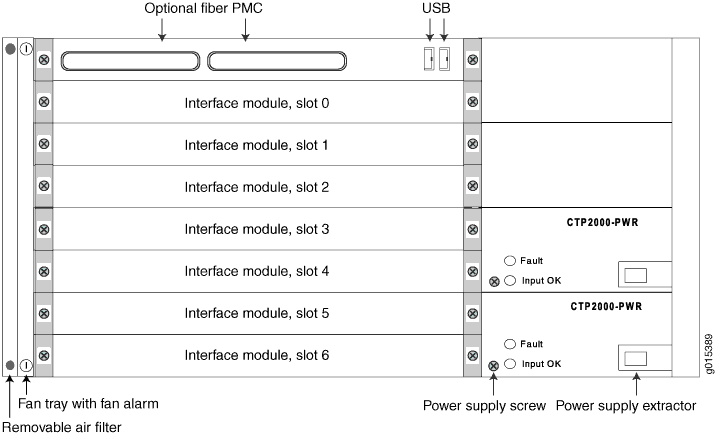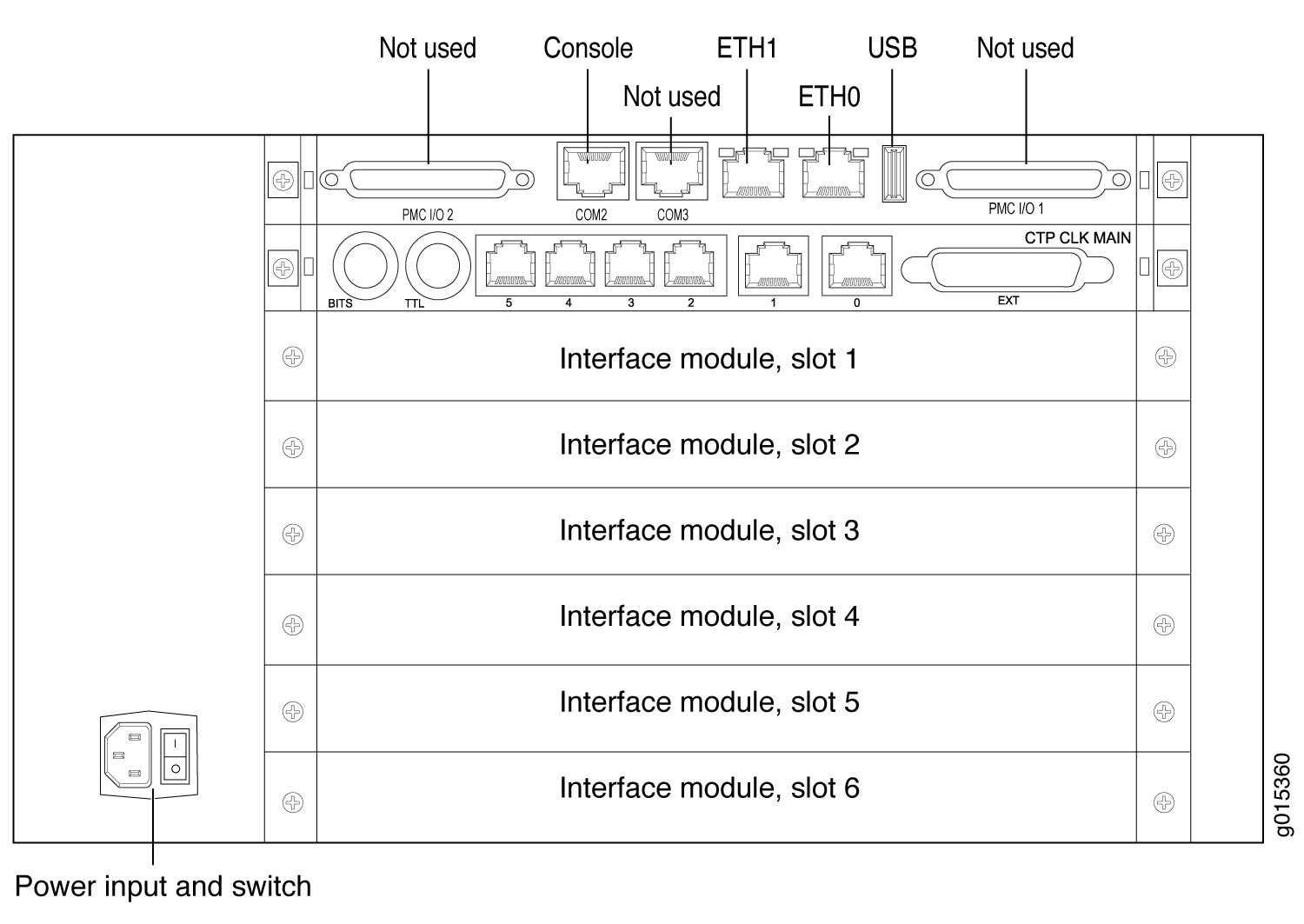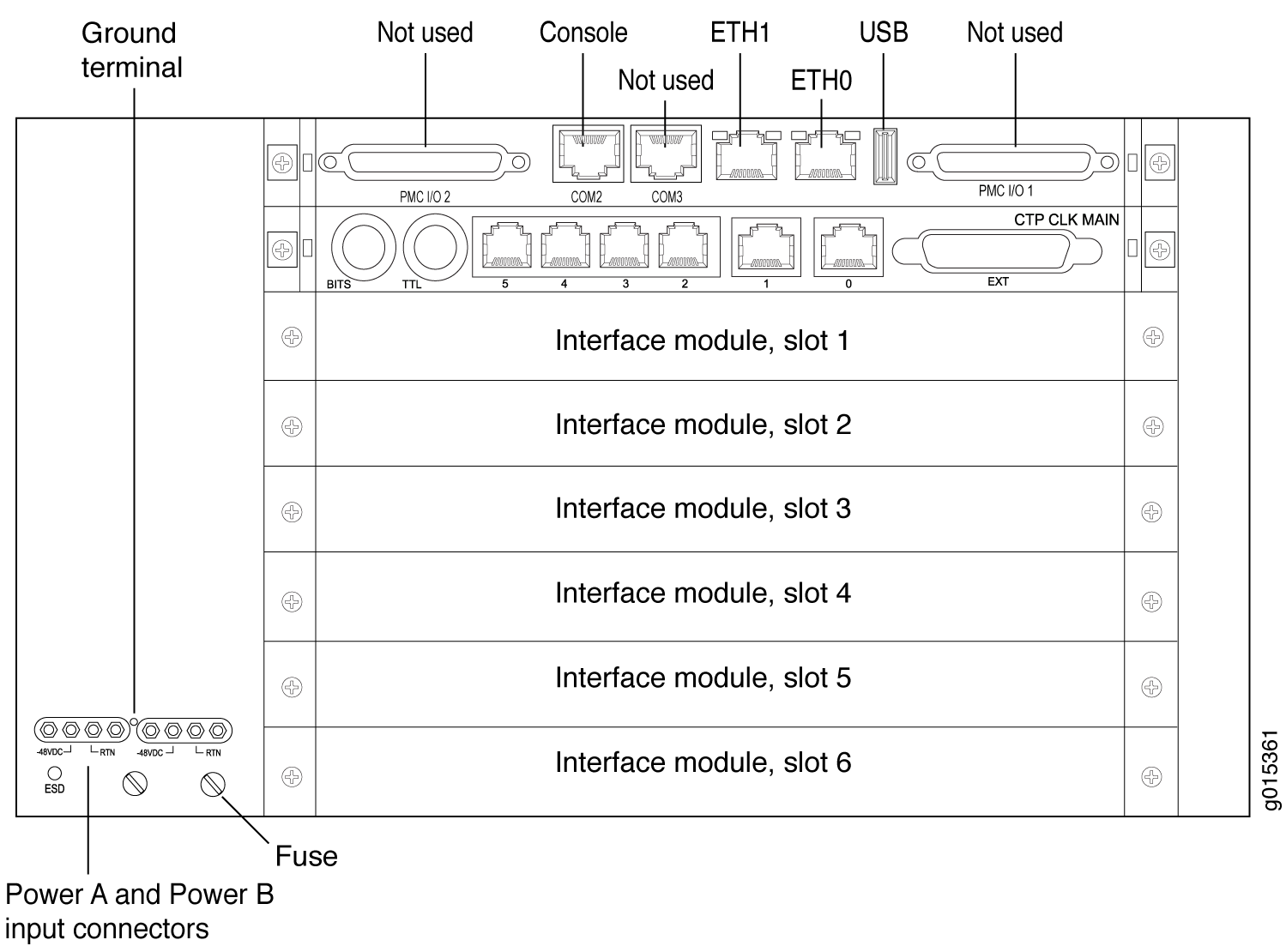CTP2056 Platform
The Juniper Networks CTP2056 Circuit to Packet platform can have up to seven removable interface modules and one removable processor module, and is available in both AC-powered and DC-powered versions. It has a removable fan tray, and the airflow is side-to-side.
PP310 is a Generation 1 or Gen 1 CPU.PP332 is a Generation 2 or Gen 2 CPU.PP833 is a Generation 3 or Gen 3 CPU.PPF84 is a Generation 4 or Gen 4 CPU.
The generation of the CTP system (that is, which CPU was in the purchased CTP2000 system) is indicated in the suffix of the model number. Example: CTP2056-AC-04 is a Gen 4 system with PPF84 CPU.
Figure 1, Figure 2, and Figure 3 show the CTP2056 chassis containing the PP332 (Gen 2 CPU) processor (which requires an RTM card for Ethernet and console port accesses). The new PPF84 (Gen 4 CPU) or PP833 (Gen 3 CPU) processor module does not require an RTM card, as the module itself contains Ethernet and USB-connector-type Console ports. If you are upgrading from the old PP310 (Gen 1 CPU) or PP332 (Gen 2 CPU) processor to the PPF84 (Gen 4 CPU) or PP833 (Gen 3 CPU) processor, the RTM card may be left in the node. But, none of the interfaces (Ethernet or serial ports) on the RTM panel are functional.If you want to upgrade from PP833 (Gen 3 CPU) processor to PPF84 (Gen 4 CPU) processor, see Upgrading from PP833 to PPF84 Processor.

The front panel comprises the following components (see Figure 1):
Processor module—This is the system controller. There are two optional fiber PMC (PCI mezzanine card) locations at the top for inserting SFP PMC modules. For more information about the PMC module, see CTP2000 PMC Module and Installing a PMC on CTP2000 Platforms.
Interface modules—Include customer facing revenue interfaces, with frame processing and forwarding engines.
Power supply—To extract, loosen power supply screw, push the extractor button, and lift lever to eject the power supply module.
Fan tray and air filter—To remove the fan tray, loosen thumb screws on the air filter and pull out. Once removed, loosen flat blade screws and pull to remove fan tray.


The rear panel comprises the following components (see Figure 2 and Figure 3):
CPU RTM module—This Rear Transition Module (RTM) goes behind PP310/PP332 (Gen1/Gen2) CPU card only. Otherwise, it is not used and can be removed. If used, it has the following interfaces:
Ethernet connection—Provides the 1-Gbps Ethernet connection to the IP network by means of a local Ethernet switch or router.
-
Console connection—Provides an asynchronous tty connection for locally configuring the CTP Series device. On the PP310 and PP332 processors, you can connect a console directly to the COM2 port (which is an RJ-45 type connector) found on the RTM panel.
Note:The CPU RTM RJ45 console pinout is different from other RJ45 console pinouts. See CTP2000 Series Console Cable Pinouts
USB: Can be used for software updates.
Clock module—This Rear Transition Module (RTM) goes behind interface module slot 0, and provides RS422, BITS, and TTL clock inputs for physical clock references. It also provides clock distribution between modules when the backplane is in use by voice applications.
Power input—Use a standard IEC power cord for the AC version. Use a 22-AWG fork terminal connector for the DC version. Power redundancy is supported for the AC version and the DC version. A single IEC power cord is sufficient to connect the redundant AC power supply modules, which keeps the chassis turned on in the event of failure of one of the power supplies.
Note:There are no power switches on CTP2000 Series DC models. So, a readily accessible disconnect device must be provided as part of the electrical installation of the unit. We recommend the 22-AWG wire for DC power terminals.
